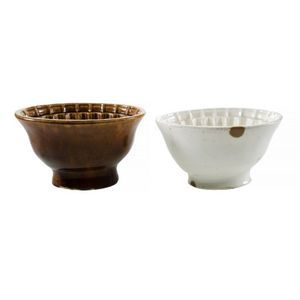Victorian Lithgow Jelly Moulds - Creamware, Chipped - 13cm
You must be a subscriber, and be logged in to view price and dealer details.
Subscribe Now to view actual auction price for this item
When you subscribe, you have the option of setting the currency in which to display prices to $Au, $US, $NZ or Stg.
- Victorian Period - The Victorian period of furniture and decorative arts design covers the reign of Queen Victoria from 1837 to 1901. There was not one dominant style of furniture in the Victorian period. Designers used and modified many historical styles such as Gothic, Tudor, Elizabethan, English Rococo, Neoclassical and others, although use of some styles, such as English Rococo and Gothic tended to dominate the furniture manufacture of the period.
The Victorian period was preceded by the Regency and William IV periods, and followed by the Edwardian period, named for Edward VII (1841 ? 1910) who was King of the United Kingdom and the British Dominions and Emperor of India for the brief period from 1901 until his death in 1910. - Creamware - Creamware, also known as "Queens Ware" is the
cream-coloured English earthenware developed by Josiah Wedgwood in the 1760s.
The invention of creamware was the result of experimentation in order to find a
British substitute for imported Chinese porcelain, and the cream colour was
considered a fault at the time. The lightweight fine white earthenware with a
clean rich yellowish proved ideal for tableware
and decorative items during the 18th and 19th centuries and is still produced
today.
Creamware is made from a
mixture of kaolin, feldspar, and ball clay, and is typically glazed before
firing to give it its glossy finish. It was developed by British potters as a
cheaper alternative to porcelain.
At Wedgwood, Royal patronage
boosted sales. In 1765 Queen Charlotte, the consort of King George III placed
an order for a 12 place tea set and allowed Wedgwood to use the name
"Queens Ware" for the line. In 1770 Wedgwood produced a creamware
dinner service of 952 pieces supplied to Catherine II the Great of Russia.
Other potteries such as
Doulton, Neale & Co. and Spode produced smaller quantities of creamware.
Creamware continued to be
made throughout the 19th century and later.
This item has been included into following indexes:
Visually similar items

A pair of Shigeo Shiga pottery tea bowls, circa 1968, 6.5 cm high

Stephen Bowers (b. 1952), two ceramic bowls earthenware, hand painted marbling-effect underglaze. Height 10 cm, diameter 18 cm

Italian Murano art glass vase with applied rope handle, signed, height 30 cm. Provenance: Orlando Brown Collection, Mosman

Pair of Chinese porcelain stem cups, two fine porcelain cups raised on tall stems, with doucai floral decoration with gilt highlights and details six character period mark to foot, height 7.5 cm (2)
